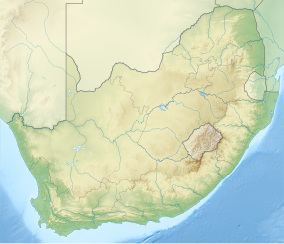Tsitsikamma National Park
| Tsitsikamma National Park | |
|---|---|
|
IUCN category IV (habitat/species management area)
|
|

A river mouth in the Tsitsikamma National Park
|
|
|
Tsitsikamma National Park location
|
|
| Location | Western Cape and Eastern Cape, South Africa |
| Nearest city | Knysna |
| Coordinates | 34°01′S 23°53′E / 34.017°S 23.883°ECoordinates: 34°01′S 23°53′E / 34.017°S 23.883°E |
| Established | 2009 |
The Tsitsikamma National Park is a protected area on the Garden Route, Western Cape and Eastern Cape, South Africa. It is a coastal reserve well known for its indigenous forests, dramatic coastline, and the Otter Trail. On 6 March 2009 it was amalgamated with the Wilderness National Park and various other areas of land to form the Garden Route National Park.
The park covers an 80 kilometres (50 miles) long stretch of coastline. Nature's Valley is at the western end of the park, and the main accommodation is at Storms River Mouth. Near the park is the Bloukrans Bridge, the world's highest bungee jump at 216 metres (709 ft).
The word "Tsitsikamma" hails from the Khoekhoe language tse-tsesa, meaning "clear", and gami, meaning "water", probably referring to the clear water of the Tsitsikamma River. Other meanings are 'place of much water' and 'waters begin'.
Various amenities, including a restaurant, shop, chalets, camp site and caravan park, information centre, adventure bookings office, the Agulhas lookout platform, trees marked with their national tree list numbers and underwater trails.
This camp is situated in De Vasselot on the banks of the Groot River, about 30 km from Plettenberg Bay and about 40 km from Storms River Rest Camp. It is an ideal region for bird watchers and has a variety of trails for hikers.
The Otter Trail starts at the Storms River camp and the South African National Parks has laid out several short trails for day visitors. Set in the Garden Route, the trails lead through coastal and forest scenes, as well as various waterfalls, streams and rivers.
...
Wikipedia

